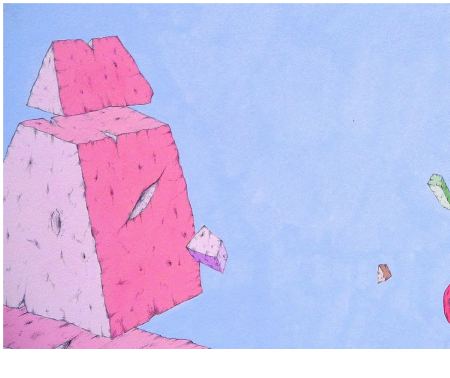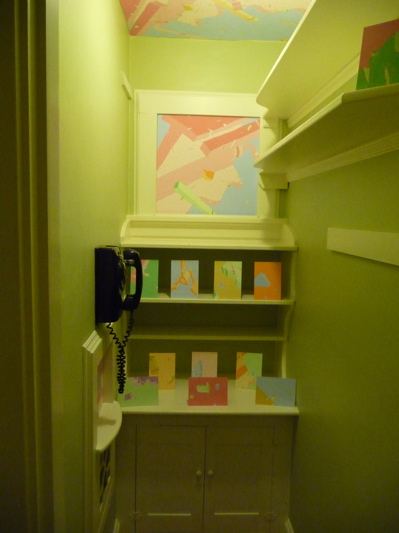At 12.5 square feet, The Telephone Room in Tacoma is not the smallest gallery in the world but must be in the tiny top ten.
From its Web site:
It is located in a Dutch Colonial home in Tacoma and since 1930, its sole purpose has been to house a black rotary dial telephone. Until now…The Telephone Room is small, but its mission is big: to house artist-driven exhibits and programming. Big ideas in an intimate space.
Opening tomorrow night are Blake Haygood‘s new drawings under the collective title of Is You Is, in gouache and graphite on ragboard.
 Haygood began as a printmaker and still paints in a modified printmaking style, incising form into wood panels and painting in layers through a process of erasure, laying on and partially wiping out. When he began painting earlier in the decade, acrylics in a mineral varnish woke up his
Haygood began as a printmaker and still paints in a modified printmaking style, incising form into wood panels and painting in layers through a process of erasure, laying on and partially wiping out. When he began painting earlier in the decade, acrylics in a mineral varnish woke up his
weightless world.
Born in Athens, Ga., in 1966, he grew up in a smaller, more rural town nearby, spending a lot of time at his grandfather’s farm bordered by woods.
Untended, the farm had slid into disrepair. Beyond a barn with a caved-in roof and machinery rotting in the field was the woods, also strewn with broken machines.
A walk in the countryside meant a scramble over dumped refrigerators, cars and parts of cars, washing machines, buzz saws, bikes and bed posts.
Wild grasses, mosses and tree saplings used the machinery as nurse logs, shooting up inside it and growing large enough to shoulder it aside or bury it.
Haygood’s new work has moved beyond the semi-pastoral decay of the old South to explore more remote cosmologies. Inside them, densities of cut stone or wood linger on their blunt bases before pushing off into the air. His forms may be eroded, but his soft hues are always brand new. He is a master of the potent blank. He takes his cues from traditional Chinese landscape artists who created air, water and mountains largely by leaving them empty. Haygood’s forms are lovely, but it’s the colored air around them makes them matter.
Is You Is is half a line. Musically, it ends in a love song. Although Haygood uses the reference to mark a career turning point, no longer part-time painter and part-time art dealer but painter full-time, his paintings make the song their own. What is lost, ruined or left behind is desirable again in the redeeming space he makes for it.
Update: Better image via




Regina,
Blake Haygood(Hay is good?)is a favorite and I always enjoy it when you feature this artist’s efforts.
Your assessment in this current posting is especially worthy and your descriptive choice of words highlight your own personal abilities.
Surely, if you put a simple cube within a vacant space, you’d be hard pressed to make it float. Blake, however, rectifies and offers a solution by a suggestion of a previous(past) or promised(future) connection. Space, gravity, and relationships are all tools of the trade. I am reminded of God’s release of Adam from his fingertip as well as the effort required when attempting to join the like-poles of magnets.
Haygood has found a way to paint the invisible and he has given additional power to many other forms of negative space.
The playfullnes of this art belies what is really a mining of serious explorative thought.